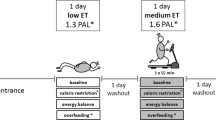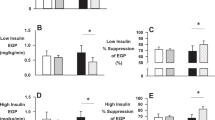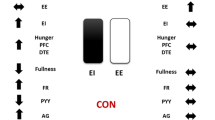Abstract
OBJECTIVE:
To investigate whether time interval between meal and exercise alters the balance of substrate oxidation during an exercise bout.
HYPOTHESIS:
Exercise performed 3-h after meal induces a higher rate of lipid oxidation than when performed only 1-h after meal.
RESEARCH METHODS AND PROCEDURES:
Eight overweight and obese postmenopausal women (age: 57.4±2.4 y; BMI: 31.8±2.1 kg m−2; %FAT: 42.7±1.2%, mean±s.e.m.) performed two sessions of exercise training at an intensity corresponding to their ‘ crossover’ point of substrate oxidation (COPox). One session was held 1 h after a standardized meal and the other, 3 h after an identical meal on another day. Substrate oxidation was evaluated by indirect calorimetry. Hormonal responses were investigated during exercise.
RESULTS:
Respiratory exchange ratio values were lower in the 3-h condition, showing higher lipid oxidation during exercise (average difference+38.9±2.7 mg min−1; P<0.001), while mean energy expenditure did not differ. Basal heart rate was reduced in the 3 h compared with the 1-h condition (78±5 vs 87±5 bpm; P<0.05). Glycemia, lactatemia and insulinemia were reduced when exercise was performed 3 h after meal (P<0.05).
DISCUSSION:
When exercise is performed 3 h after meal at an intensity corresponding to the COPox, metabolic and hormonal responses are similar to those targeted during the submaximal exercise test performed at fast that we previously proposed to individualize exercise training in the obese.
This is a preview of subscription content, access via your institution
Access options
Subscribe to this journal
Receive 12 print issues and online access
$259.00 per year
only $21.58 per issue
Buy this article
- Purchase on Springer Link
- Instant access to full article PDF
Prices may be subject to local taxes which are calculated during checkout






Similar content being viewed by others
References
Tremblay A, Doucet E, Imbeault P . Physical activity and weight maintenance. Int J Obes Relat Metab Disord 1999; 23: S50–S54.
van Aggel-Leijssen D, Saris W, Wagenmakers A, Senden J, Van Baak M . Effect of exercise training at different intensities on fat metabolism of obese men. J Appl Physiol 2002; 92: 1300–1309.
van Baak M . Exercise training and substrate utilisation in obesity. Int J Obes Relat Metab Disord 1999; 23: S11–S17.
Thompson D, Townsend K, Boughey R, Patterson K, Bassett DJ . Substrate use during and following moderate- and low-intensity exercise: implications for weight control. Eur J Appl Physiol 1998; 78: 43–49.
Kim JY, Hickner RC, Cortright RL, Dohm GL, Houmard JA . Lipid oxidation is reduced in obese human skeletal muscle. Am J Physiol Endocrinol Metab 2000; 279: E1039–E1044.
Perez-Martin A, Dumortier M, Raynaud E, Brun J, Fédou C, Bringer J, Mercier J . Balance of substrate oxidation during submaximal exercise in lean and obese people. Diabetes Metab 2001; 27: 466–474.
Colberg S, Simoneau J, Thaete F, Kelley D . Skeletal muscle utilization of free fatty acids in women with visceral obesity. J Clin Invest 1995; 95: 1846–1853.
Brandou F, Dumortier M, Garandeau P, Mercier J, Brun JF . Effects of a two-month rehabilitation on substrate utilization during exercise in obese adolescents. Diabetes Metab 2003; 29: 1–7.
Dumortier M, Brandou F, Perez-Martin A, Fedou C, Mercier J, Brun J . Low intensity endurance exercise targeted for lipid oxidation improves body composition and insulin sensitivity in patients with the metabolic syndrome. Diabetes Metab 2003; 29: 509–518.
Dumortier M, Perez-Martin A, Pierrisnard E, Mercier J, Brun JF . Regular exercise (3 × 45 min/wk) decreases plasma viscosity in sedentary obese, insulin resistant patients parallel to an improvement in fitness and a shift in substrate oxidation balance. Clin Hemorheol Microcirc 2002; 26: 219–229.
Poirier P, Tremblay A, Catellier C, Tancrede G, Garneau C, Nadeau A . Impact of time interval from the last meal on glucose response to exercise in subjects with type 2 diabetes. J Clin Endocrinol Metab 2000; 85: 2860–2864.
Crampes F, Marion-Latard F, Zakaroff-Girard A, De Glisezinski I, Harant I, Thalamas C, Stich V, Riviere D, Lafontan M, Berlan M . Effects of a longitudinal training program on responses to exercise in overweight men. Obes Res 2003; 11: 247–256.
Wasserman K, Hansen J, Whipp B . Principles of exercise testing and interpretation. Febiger : Philadelphia L; 1986; pp: 50–80.
McRae H, Noakes T, Dennis S . Role of decreased carbohydrate oxidation on slower rises in ventilation with increasing exercise intensity after training. Eur J Appl Physiol Occup Physiol 1995; 71: 523–529.
Brooks G, Mercier J . Balance of carbohydrate and lipid utilization during exercise: the ‘crossover concept’. J Appl Physiol 1994; 76: 2253–2261.
McGilvery R, Goldstein G . Biochemistry. A functional approach. Saunders: Philadelphia, PA; 1983; pp: 810–976.
Frayn K . Calculation of substrate oxidation rates in vivo from gaseous exchange. J Appl Physiol 1983; 55: 628–634.
Brooks GA . Amino acid and protein metabolism during exercise and recovery. Med Sci Sports Exerc 1987; 19: S150–S156.
Ferrannini E . The theoretical bases of indirect calorimetry: a review. Metabolism 1988; 37: 287–301.
Kanaley J, Mottram C, Scanlon P, Jensen M . Fatty acid kinetic responses to running above or below lactate threshold. J Appl Physiol 1995; 79: 439–447.
Romijn JA, Coyle EF, Hibbert J, Wolfe RR . Comparison of indirect calorimetry and a new breath 13C/12C ratio method during strenuous exercise. Am J Physiol 1992; 263: E64–E71.
Romijn JA, Coyle EF, Sidossis LS, Gastaldelli A, Horowitz JF, Endert E, Wolfe RR . Regulation of endogenous fat and carbohydrate metabolism in relation to exercise intensity and duration. Am J Physiol 1993; 265: E380–E391.
Brun JF, Fedou C, Bouix O, Raynaud E, Orsetti A . Evaluation of a standardized hyperglucidic breakfast test in postprandial reactive hypoglycaemia. Diabetologia 1995; 38: 494–501.
Issekutz B, Miller H . Plasma free fatty acid during exercise and the effect of lactic acid. Proc Soc Exp Biol Med 1962; 110: 237–245.
Arner P, Bolinder J, Ostman J . Glucose stimulation of the antilipolytic effect of insulin in humans. Science 1983; 220: 1057–1059.
Manetta J, Brun JF, Maimoun L, Galy O, Coste O, Maso F, Raibaut JL, Benezis C, Lac G, Mercier J . Carbohydrate dependence during hard-intensity exercise in trained cyclists in the competitive season: importance of training status. Int J Sports Med 2002; 23: 516–523.
Yi JJ, Fullwood L, Stainer K, Cowley AJ, Hampton JR . Effects of food on the central and peripheral haemodynamic response to upright exercise in normal volunteers. Br Heart J. 1990; 63: 22–25.
Acknowledgements
We thank the physicians and the nursing and technical staff of the ‘Centre d'Exploration et de Réadaptation des Anomalies du Métabolisme Musculaire’ for their assistance in conducting this study. We also thank all of the women who volunteered to participate.
Author information
Authors and Affiliations
Corresponding author
Rights and permissions
About this article
Cite this article
Dumortier, M., Thöni, G., Brun, J. et al. Substrate oxidation during exercise: impact of time interval from the last meal in obese women. Int J Obes 29, 966–974 (2005). https://doi.org/10.1038/sj.ijo.0802991
Received:
Revised:
Accepted:
Published:
Issue Date:
DOI: https://doi.org/10.1038/sj.ijo.0802991
Keywords
This article is cited by
-
Comparison of energy expenditure and substrate metabolism during overground and motorized treadmill running in Chinese middle-aged women
Scientific Reports (2020)
-
Energy expenditure and substrate oxidation during and after eccentric cycling
European Journal of Applied Physiology (2014)
-
Obésité, diabète de type 2, et activité physique
La Lettre de médecine physique et de réadaptation (2012)
-
Exercise, substrate oxidation and energy balance
International Journal of Obesity (2006)



